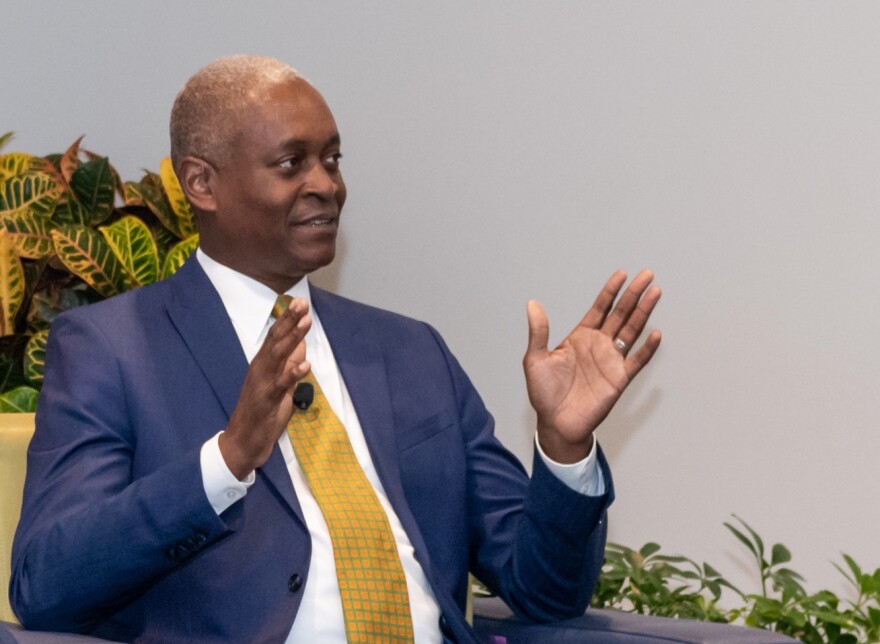The president of the regional Federal Reserve thinks a small cut in the bank's target interest rate is appropriate before the end of the year, but Raphael Bostic did not commit to when that reduction may happen.
Bostic is not a voting member of the Fed’s Open Market Committee, the group that sets the bank’s target short term interest rate. But as the leader of the Federal Reserve Bank of Atlanta, whose territory includes Florida, he has a seat at the table when it discusses economic conditions and borrowing rates.
"Some easing in policy — probably on the order of 25 basis points — will be appropriate over the remainder of this year."Federal Reserve Bank of Atlanta Pres. Raphael Bostic
“Uncertainty abounds,” he wrote in his quarterly message released Wednesday. He said as he traveled throughout the southeast this summer, businesspeople report they are not confident in their own business outlook for the next six months.
“I poll audiences on who feels confident in their business forecast for the next six months. In recent weeks, nary a hand has gone up,” he wrote.
The Fed meets in two weeks for its next interest rate decision. It is widely expected to cut borrowing rates for the first time in more than a year and a half. President Donald Trump has been extremely vocal in his criticism of the bank, especially Chair Jermone Powell, for not reducing interest rates. Trump reportedly drafted a letter in July firing Powell
Amid the political intrigue for the famously apolitical agency, Bostic focused on economic fundamentals in his assessment of the regional and national economy.
“ Inflation remains above target and the labor market is cooling, and this makes the job of the Fed's policy setting federal open market committee, especially challenging,” he wrote.
Bostic pointed out the Fed’s preferred inflation gauge, the personal consumption expenditure price index, has been above the bank’s 2% target for four years and counting.
Regional inflation rates are trickier to draw conclusions from, but South Florida’s Consumer Price Index was 3.1% in June, the most recent month data is available.
Bostic narrowed his examination of inflation to core services. Those strip out changes in gasoline prices, which can vary widely month-to-month, but includes healthcare costs, car maintenance and insurance. Bostic pointed to this inflation measurement as “preventing a fulsome return” to the Fed’s inflation target of 2%.
He also nodded to the potential impact of tariffs on the price of goods. President Trump has issued and paused various tariff rates on imported goods from dozens of countries since early April. An analysis by Yale indicates the effective tariff rate for consumers is over 18%, the highest since the 1930s.
READ MORE: How can a product be imported tariff-free to Miami without entering the U.S.? Welcome to the FTZ
Imports into PortMiami fell by 9% in June compared to a year earlier, according to data from USTradeNumbers.com. Exports were up 2%. Year-to-date, imports into Miami International Airport were down 5% over the first half of the year. Imports have grown this year through PortEverglades.
Bostic said, “The puzzle I'm grappling with is whether those inflationary effects of tariffs will quickly pass or prove more persistent.” He said business contacts throughout the region report experiencing higher costs because of tariffs, but most are absorbing them instead of passing them along to buyers.
Stubborn inflation over the Fed’s target would usually argue for steady or even higher interest rates in order to cool it down. However, the Fed also is required to set policy to encourage maximum employment, which can be helped by lower borrowing costs. And the national job market has shown signs of slowing in recent months.
“Cooling, not collapsing” is how Bostic describes the job market.
Florida’ unemployment rate was 3.7% in July, up 0.3% from a year earlier. Miami-Dade County had the lowest rate in the state at 2.8%.
The national August jobs report is due to be released Friday by the Department of Labor. President Trump fired the department’s secretary a month ago after the agency revised down job gains from earlier in his administration. Jobs data revisions are not unusual.
Bostic noted the national unemployment rate has remained steady at just above 4%. While job creation has slowed considerably, the labor force has shrunk.
“If labor demand and labor supply are both slowing such that the unemployment rate is stable, then the labor market has not meaningfully weakened and, in fact, remains near full employment. In other words, we are still close to the Committee's maximum employment objective,” he wrote.






